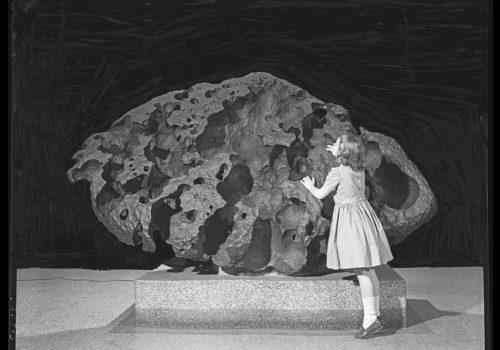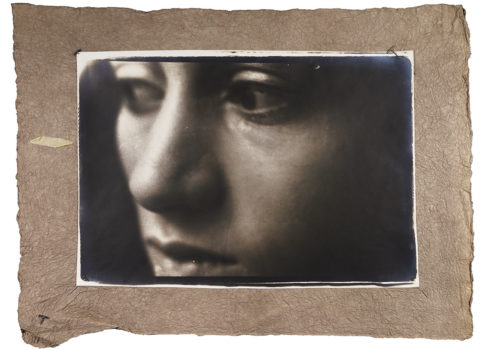Even the title of the 23rd International Exhibition suggests curiosity and a desire for discovery. While entering the spaces of the Triennale Milano, curiosity turns into culture, by walking around the many exhibitions paths. Indeed, it’s not just one exhibition, but several shows linked together in an interplay of cross-references. By the way, we suggest you to keep an eye on the 2023 program, which will be unveiled soon, dedicated to the centenary of Triennale Milano.
The 23rd International Exhibition is thought of as a space for open debate and comparison, where different experiences, cultures and perspectives can come together, focusing on different topics, like the evolution of the cities, oceans, genetics, astrophysics and more.
In line with its historical editions, it includes a thematic exhibition, Unknown Unknowns. An Introduction to Mysteries curated by Ersilia Vaudo, astrophysicist and Chief Diversity Officer at the European Space Agency, and two other major shows: Mondo Reale, conceived by Hervé Chandès, Directeur général artistique of the Fondation Cartier pour l’art contemporain, and La tradizione del nuovo, curated by Marco Sammicheli, Director of the Triennale’s Museo del Design Italiano. Furthermore, there are installations, special projects and a section dedicated to international participations.
L’Oeil asked Stefano Boeri, President of Triennale Milano, about the Triennale “phenomenon” and its relevance over time.
“When we think of Triennale Milano, we are used to juxtaposing three distinct elements to one single definition: a Palace in Milan built in 1933; a cultural Foundation promoted a century ago by public institutions but open to private contributions; and a triennial International Exhibition that, since 1928, the date that marks our presence in the BIE –Bureau International des Expositions, has defined the history of Italian culture in the world.
In recent years we tried to add a fourth element to the mix, an all-embracing definition that would enhance the value of the ones mentioned above. This element, at once simple and ambitious, marks our will to become, or rather to return and be, Triennale Milano, a School. A place where the proximity with beautiful objects and spaces, together with the circulation of rhapsodic ideas, unexpected concepts and powerful images, is an opportunity for the transmission of knowledge”.
As Stefano Boeri explains, Triennale Milano is a school with a public vocation (the programming choices follow the cultural growth of its public), an open school of higher education, as well as a school of arts and crafts, in its noblest sense: together with a theme or an issue, it approaches a technique, an application method, sometimes even a praxis.
“And, finally, a school, meaning an institution that takes the responsibility to remember and to avoid any memory loss; Triennale is so in its role of physical collector and diachronic magnet of objects, biographies and spaces that hold and release around them the sense of time. In the Milanese School at Viale Alemagna 6, people are taught without lecturers or classes, but through the expressive languages of bodies, images, places, and objects from different disciplines.
In its extraordinary collection of empty spaces (the true creation of Giovanni Muzio’s genius), so powerful and yet so flexible as to allow continuous destruction and reconstruction, Triennale Milano offers every day, to everyone, without impositions or entry codes, the real-time experience of sharing knowledge, each time re-actualized by the individual paths and perceptions of visitors”, Stefano Boeri adds, underlining that Triennale Milano, is also an extraordinary opportunity “to feel part of a large, open, generous and restless School of Culture”.
The different visiting paths in Triennale Milano, also include a “photographic” one: just follow the pictures, that are exhibited in almost every exhibition section.
Curated by Ersilia Vaudo, Unknown Unknowns addresses themes like gravity, seen as “the greatest designer”, an artisan that tirelessly shapes the universe to which we belong; maps, systems by which trajectories and routes are determined, the sound of the Earth or the mysteries linked to deep space.
So, L’Oeil questioned Ersilia Vaudo about the Unknown, the uncertainty, and the computation precision for trajectories and how they can be reconciled in our today’s world.
“One of the core concepts of the exhibition Unknown Unknowns. An Introduction to Mysteries is the idea of creating a sense of belonging to a reality that is larger than us and still we are part of it. The unknown is a dimension that we can embrace and slide into. Still, there is a future that does not belong to the Unknown and it is rather deterministic and shaped by physics. Some of the works exhibited at Triennale Milano play on this theme of human finitude, foreseeing our future and reconciling the precision of trajectories with the unknown. That’s the case for ESA’s Gaia mission, creating the most accurate and complete multi-dimensional census of the Milky Way By mapping the positions and motions of almost two billion stars.
Mathematics falls under similar premises, being our way into the unknown through rationality; they are two elements that can be reconciled perfectly. And in our exhibition mathematics becomes subject and object, for instance, in the work of Protey Temen, who explores formulas and codes, abstracts them visually and exalts their aesthetic component. A mathematics that shines, that can provide fragments of reality still impossible to imagine or still not imagined, as in the case of the equation of Paul Dirac that revealed the existence of anti-matter, which only later was observed for the first time by the physicist Carl David Anderson by using a cloud chamber photography to measure cosmic rays. His discovery of an anti-particle brought him the Nobel Prize in Physics in 1936. The power of that image is extraordinary and definitive. A thin track on a grey background, and reality suddenly expands to include new worlds. And, inevitably, new unknowns. The nature of anti-matter”.
Then visitors can enter Mondo Reale, conceived by Hervé Chandès, which, within an exhibition design by Formafantasma, brings together works by 17 established and emerging contemporary artists, encompassing all media, including photography. The show explores the real as a rather contemplative and aesthetic experience which invites us to be astonished at reality and disoriented by it.
As Mondo Reale is constantly dialoguing with Unknown Unknowns, L’Oeil asked Grazia Quaroni, Director of Collections of the Fondation Cartier pour l’art contemporaine, why are visitors so fascinated by reality as it is explored as a rêverie?
“Mondo Reale has been designed to respond to the many questions raised by Unknown Unknowns, such as man’s relation to the mystery. It does so with special attention to the aesthetics and emotions, linked to the disorienting feeling of finding oneself in both ordinary and extraordinary situations that Planet Earth has to offer. The unknown provokes disorientation and uncertainty, but also sparks curiosity: without these feelings, there would be no production of knowledge. There is no final answer, only other questions – and this keeps us in a constant desire to know more.
The exhibition is a gathering of different voices: this multiplicity, this constellation of artistic attitudes – some metaphysical and philosophical, others physical and pragmatic – tackles the very essence of humanity: its instinct to defy a one-dimensioned, objective reality by reinventing it through imagination. Rêverie is a way of exploring, that makes the mystery more graspable. Artists and scientists both use dream-like visions in order to go beyond the real and into knowledge. Art pushes towards a deeper knowledge of the mysteries of the Universe, as science does”.
Whether associated with the beauty of mathematics and nature or symbolically charged materials, every work in the exhibition is an emotional landscape. It is as though after walking through the unknown of the universe in the different sections of the International Exhibition, we suddenly come back to the place we know best – the planet we inhabit and its everyday and exceptional occurrences.
La Tradizione del Nuovo (The tradition of the new), the exhibition curated by Marco Sammicheli, takes up the theme of the 23rd International Exhibition with the idea that Italian design has always adopted a determined approach of exploration, taking on the not yet known, and facing the challenge of what has not yet been allowed or made possible by research. Tradition is inextricably linked to a constant search for what is new. Starting from the permanent collection of the Museo del Design Italiano and the archives of the Triennale International Exhibitions, the show reconstructs its key events, illustrating the research that has been carried out over the years by individuals, schools and collectives.
L’Oeil asked Marco Sammicheli what was and will be the role of Italian design in defining the environment in which we live and why it was so internationally successful.
“Triennale Milano has always been a place for innovations and creativity, gathering some of the greatest Italian and international designers. Our Museo del Design Italiano here perfectly embodies this concept, exhibiting pieces from the period 1946-1981, regarded by historians and critics as one of the most important in the history of Italian design: the decades between the early post-war period and the economic boom that soon followed, up to the early 1980s, when new exuberant trends such as Alchimia and Memphis took centre stage, initiating a new era of production in Italy and around the world. From that period, one can think of the great 1972 MoMA exhibition Italy: The New Domestic Landscape to have an idea of the impact of Italian design internationally. On that occasion, Ettore Sottsass, Gae Aulenti, Joe Colombo, Vico Magistretti and others showcased their innovative ideas, creating a clear statement of how Italian design was full of possibilities. This year International Exhibition brought to reimagine the set-up of the Museo del Design Italiano with a show that still holds on to the values expressed by its pieces and by the different International Exhibitions that took place over time at Triennale, following a chronological order of trends and movements”.
Don’t miss the proposals of each of the 23 International Participations contributing to the constellation of exhibitions and projects of Unknown Unknowns. An Introduction to Mysteries, that are promoted by institutions and universities as well as by numerous governments. They explore new architectural, artistic and design challenges from our relationship with nature and the environment to the perception of dreams and the mysteries hidden in everyday life, always open to innovative solutions.
The installations by Francis Kéré, winner of the 2022 Pritzker Architecture Prize, are also permeated with an aura of allure and mystery. Same for the projects Il corridoio rosso (The Red Corridor, by Giovanni Agosti, Jacopo Stoppa) and the Alchemic Laboratory (by Ingrid Poletti), Playing the Unknown (by Francesco Bianconi), the intuitions by Ettore Sottsass, the mechanical installations by Romeo Castellucci, Grand Invité 2021-24 of Triennale Milano and the film by the architect and designer Andrea Branzi.
Paola Sammartano
23rd Triennale Milano International Exhibition
Unknown Unknowns. An Introduction to Mysteries
July 15 – December 11, 2022
Triennale Milano
Viale Alemagna 6
20121 Milan, Italy
https://triennale.org/
















